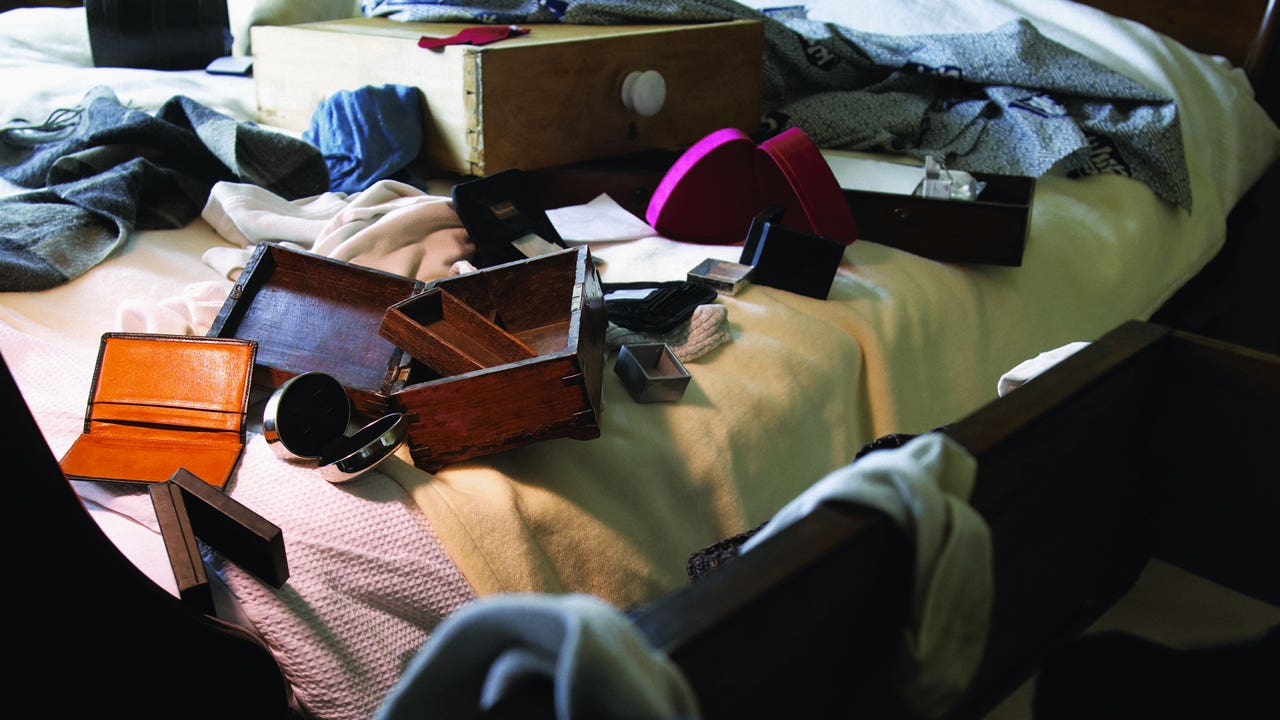Most common items stolen in home burglaries

There were nearly 75,000 burglaries reported in the United States in December 2023. While measures like a security system may keep some would-be thieves at bay, it’s also helpful to understand which items are most appealing. Some possessions should always be kept under lock and key — particularly those that can’t be replaced by home insurance. Bankrate’s insurance editorial team looked at multiple crime databases to highlight what burglars steal the most to help you better safeguard your home.
Top 10 items stolen in home invasions
According to the FBI, 2023 saw more than $267 billion in stolen property across all property types (not just residential). Only about $25 billion of that was ever recovered. Other data from the FBI shows that the average amount of dollar loss per burglary event is $2,661. You might be surprised about what burglars are after. As it turns out, they’re not only looking for new gaming systems and laptops. Prescription drugs, for instance, also make the list of most commonly stolen items from homes.
1. Wallets and cash
The amount of cash stolen in home burglaries far outweighs the value of other stolen goods, according to the FBI’s findings. Your home insurance policy does offer some protection for stolen cash, but not much. Most home policies only include around $200 for cash coverage, which is significantly lower than most home insurance deductibles. Remember, with home insurance, it’s usually only worth it to file a claim if the loss is more than your deductible amount.
2. Clothing and furs
You might not think that your wardrobe is particularly valuable to a thief, but if you have designer clothes in your closet, it’s a potential gold mine to a burglar. Thieves might be looking for designer labels, including shoes, handbags and accessories, that can be resold. Other high-quality items, like leather jackets and furs, are also a target for home burglars.
3. Prescription drugs
Stealing prescription drugs can be extremely profitable for home burglars. Medications are easily resold on the streets, which is why many home burglars target the medicine cabinet in your bathroom during a break-in. Some over-the-counter medications might also get stolen in the process. A burglar probably won’t stop to read the label, so if you keep things like painkillers, allergy medicine and even vitamins on hand, a burglar might decide to take it.
4. Cars and parts
Burglars may see your car as an easier target than your home. And stealing the car itself may not even be the goal. A band of burglars could be interested in swiping your catalytic converter. In the first six months of 2023, nearly 27,000 catalytic converters were reported stolen nationwide. A burglar could also smash your windshield in order to access items in your glove box. According to the National Highway Traffic Safety Administration (NHTSA), burglars may also be after everything from your wheel covers and transmission to your GPS unit.
6. Electronics
Electronics, like televisions, computer sets and gaming systems are common targets for burglars. Nonetheless, your phone may also be a targeted item. A study found that mobile devices are the most commonly stolen devices, at about a 73 percent rate compared to laptops and desktops, at 20 and 6 percent, respectively.
7. Jewelry and precious metals
Burglars are usually on the lookout for expensive fine jewelry and watches to steal and resell to make a profit. And it’s not just diamonds they’re hoping to get — sterling silver jewelry, gold jewelry and even costume jewelry can be resold for profit. If you have jewelry or watches lying out in plain sight, it’s fair game for potential theft.
8. Personal documents
Unfortunately, some burglars might be after your personal documents, like your Social Security card, password books and passport. If a burglar gets their hands on these items, they can use them to steal your identity or even access your financial accounts. The U.S. Federal Trade Commission (FTC) received 1.4 million reports of identity theft in 2024 alone, highlighting how frequent this serious crime takes place.
9. Firearms
Firearms are one of the most stolen items in home invasions. According to data from the Bureau of Alcohol, Tobacco, Firearms and Explosives (ATF), more than 95 percent of guns originate from thefts from private citizens (not specific to home invasions). Since many guns have an extremely high resale value, burglars often target them to quickly resell on the streets.
10. Power tools
Power tools aren’t just nabbed from construction sites. Burglars are also prone to grabbing power tools and landscaping tools from homes. They’re pretty easy to steal and can easily be resold.
How home insurance protects against loss from theft
Your home insurance policy provides financial protection for theft. Coverage C, the personal property insurance arm of your policy, covers you up to a certain amount for your stuff. Coverages A and B, dwelling and other structures, can help with structural damage after a break in. If burglars break down your front door, smash a window or break a lock on your shed, you can file a claim with your home insurance company for those losses.
“Someone stole a lawnmower, leaf blower, golf clubs, a weed whacker and other tools from my shed when my house was under construction. The electricity was turned off, so our security cameras were offline. Plus, the house was pretty obviously under construction, which made it kind of an easy target. The shed was locked, but they knocked it off with a loose brick. I filed a police report online, then I filed a claim with my home insurance company. After I met my deductible and listed all of the items that were stolen, I got the money direct deposited to my account.”
— Micheal S., Bankrate Staffer
It’s important to note that you may not be protected for the full value of some commonly-stolen items through your personal property coverage. Most insurance policies apply sub-limits to certain items for theft losses, such as:
|
Item |
Personal property sub-limit |
|
Cash and other currency |
$200 |
|
Manuscripts and other valuable papers |
$1,500 |
|
Jewelry and watches |
$1,500 |
|
Furs |
$1,500 |
|
Firearms |
$2,500 |
|
Silverware, goldware or pewterware |
$2,500 |
So, even if you have $100,000 in personal property coverage, your $10,000 necklace may only be covered for $1,500. The sub-limits listed above are approximations, and exactly what you’re covered for will depend on your policy specifics.
Tips on protecting your personal belongings
Even if you take all the right safety precautions, motivated burglars can still find ways to break into your home. However, there are plenty of ways to protect your personal items in the event of a home burglary. Here are some tips:
- Purchase property insurance: If you rent or own a home, having property insurance is a smart investment, even though it’s not required unless you have a mortgage. If someone breaks into your house, the personal property portion of your renters or home insurance policy will reimburse you for the stolen items up to your policy limits. Before you get a policy, it’s a good idea to shop around and get a few quotes to find the best policy for your situation. If you have a lot of valuables, you may want to consider scheduled personal property insurance, which could cover high-value items like expensive jewelry or art.
- Set up a security system: Home security systems could be a great line of defense against burglars. Depending on your budget, you can install a professionally-monitored system, or get a cheaper DIY-install system that you self-monitor through an app. As an added bonus, many home insurance companies offer a discount on your policy if you have a security system in your house.
- Install motion sensor flood lights: For obvious reasons, many burglars break into houses when it’s dark and they can’t be easily spotted. By installing motion sensor-activated flood lights around the perimeter of your house, you can potentially spook a burglar from going further in their attempt.
- Secure valuable items in a safe: If you keep valuable items in your home, like jewelry, art or firearms, consider storing them in a locked safe. When these items are left out, it’s very easy for a burglar to stash them in a bag or pocket and leave quickly.
- Shred sensitive documents: As a general rule of thumb, you shouldn’t keep sensitive documents that contain personal information in plain sight. Once you no longer need a document, whether it’s a bill or a credit card PIN number, it’s best to shred the document where it can’t be found. Keep in mind that burglars may try to get sensitive information by going through your trash or recycling bin, so shredding provides an added layer of protection.
- Be mindful of seasonal theft trends: If you take advantage of Black Friday for your holiday shopping, be mindful of porch piracy. If possible, get your packages delivered to a discrete location or require a signature for larger packages.
You may also like

What is home appreciation in real estate?

Surprising things your homeowners insurance covers

What are the most common home maintenance costs?



